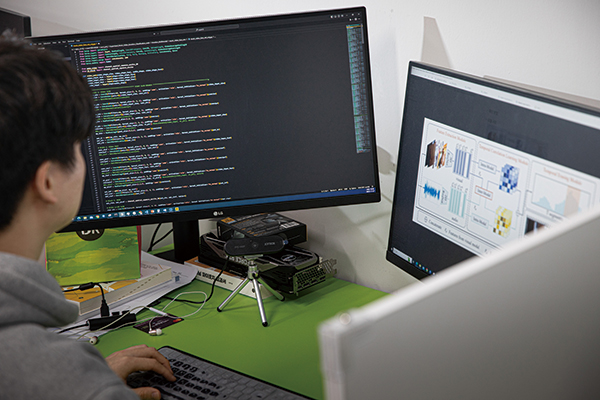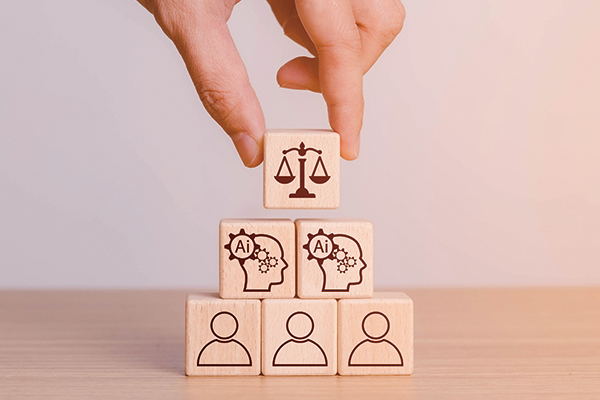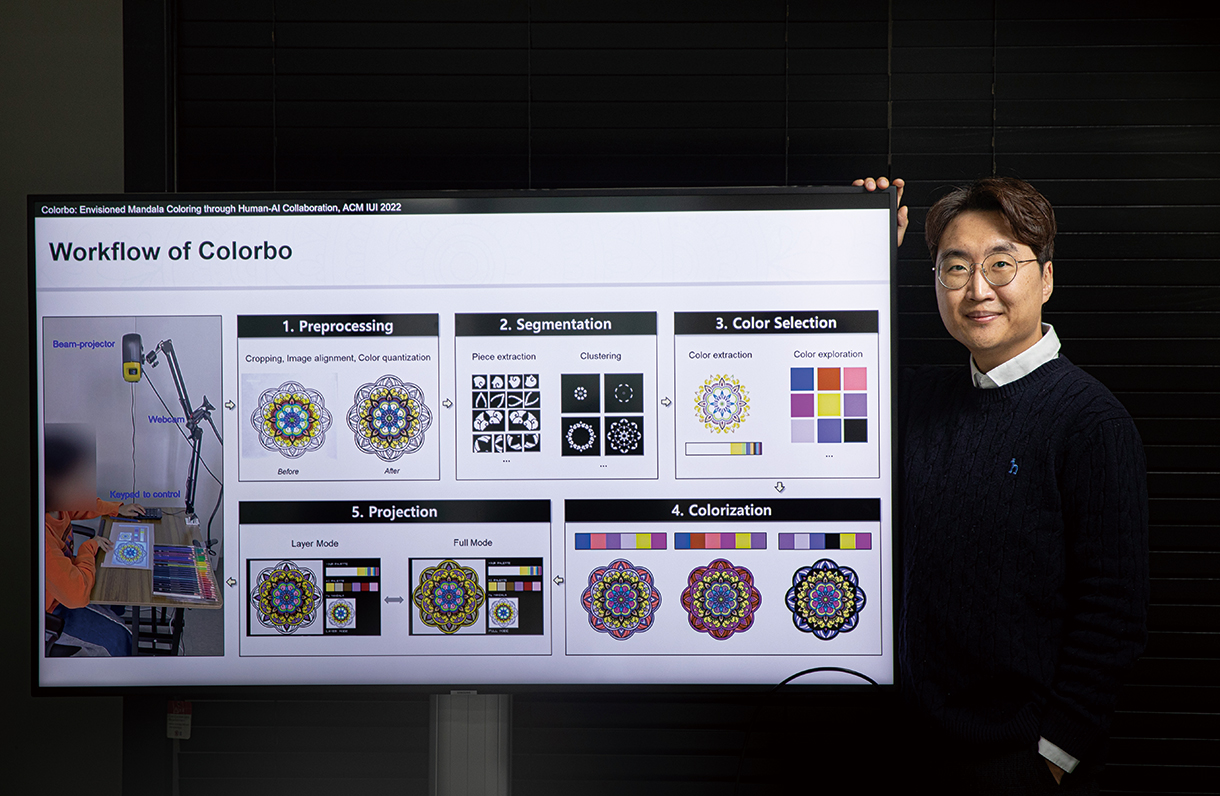

Story
인간과 상호작용으로
인공지능을 보다 이롭게
Benefiting More from Artificial Intelligence
Through Interactions with Humans
ERICA캠퍼스 ICT융합학부 고민삼 교수
Prof. Minsam Ko, Division of Media, Culture and Design Technology at ERICA Campus
- 글 박영임
- 사진 손초원
- Writing Park Yeong-im
- Photograph Son Cho-won
Scroll Down
As artificial intelligence (AI) became useful in our lives, it also became natural that AI exists in our daily lives — therefore, it would only be reasonable to seek ways to get along with it. Professor Minsam Ko, who conducts research to develop interactions between AI and humans, says that interaction with AI can be used beneficially to make humans more human.
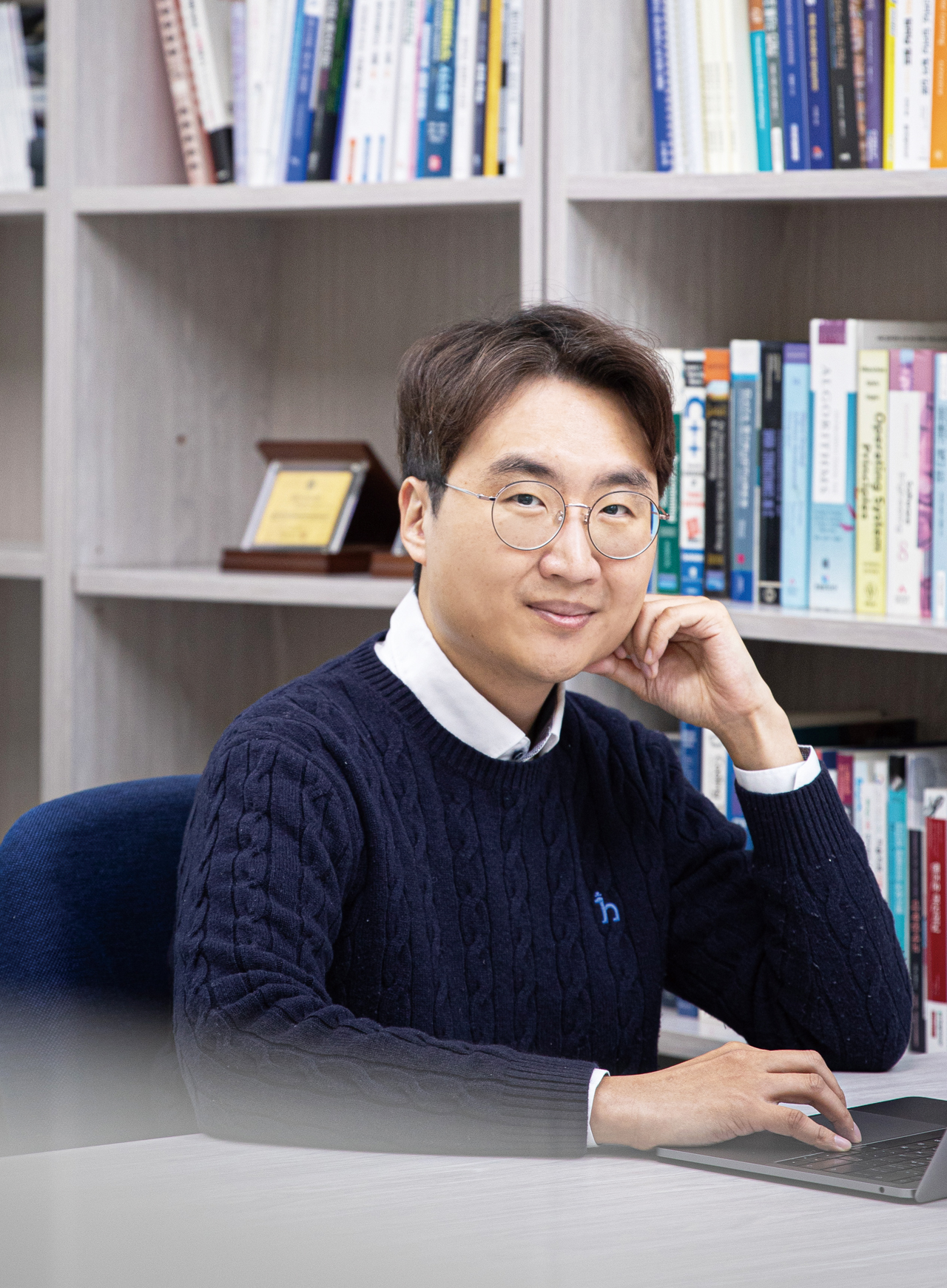
불완전하기에 상호작용이 중요
고민삼 교수는 2023년 3월 <동아일보>에 흥미로운 제목의 칼럼 하나를 게재했다. ‘챗GPT와 친구가 될 수 있을까’라는 제목이었는데, 노르웨이 과학기술공업연구원에서 실시한 챗봇과의 우정에 대한 연구 결과를 소개한 것이었다. 참여자 대부분은 유연한 접근성과 신뢰성을 챗봇과 친구가 될 수 있는 이유로 꼽았다. SF 영화의 단골 소재였던 기계와 인간의 교감이 어느새 실제 현실로 다가오고 있다. 특히 대화형 인공지능인 챗봇의 등장이 이를 가속화하는 상황이다. 학계에도 ‘인간-컴퓨터 상호작용(HCI)’ 분야에서 확장된 ‘인간-인공지능 상호작용’ 분야가 주요 연구 분야로 부상했다.
“인간-인공지능 상호작용 연구 분야는 어떻게 하면 인공지능을 잘 활용할 수 있는가를 연구하고 있습니다. 인공지능의 성능이 고도화되면서 인간과 인공지능이 상호작용해야 할 지점이 넓어지고 있어요. 인공지능 기술이 아직은 완벽하지 않으므로 인간과의 상호작용으로 보완해야 하죠. 그래서 인간과 인공지능 간 상호작용이 더욱 중요해지고 있습니다.”
GPT를 필두로 인공지능 기술이 일상생활에 자리 잡기 시작하면서 어떻게 하면 인공지능을 더 잘 활용할 수 있는지, 어디에 활용할 수 있는지에 대한 연구가 활발하게 진행되고 있다. 세계적으로는 인공지능을 선도하고 있는 미국이 인간-인공지능 상호작용 분야도 이끌고 있는데, 구글이나 마이크로소프트 같은 글로벌 기업과 스탠퍼드대학의 인간중심 인공지능연구소(HAI) 등이 관련 아젠다를 제시하는 편이다.
“인간-인공지능 상호작용을 잘 설계하기 위해서는 인간과 인공지능 모두를 잘 이해해야 합니다. 먼저 인간이 어떤 문제점을 가지고 있고, 어떤 필요가 있으며, 어떤 능력과 제한이 있는지 등을 잘 알아야 더 만족스러운 기술을 개발할 수 있죠. 그리고 인공지능 기술이 어떤 일들을, 어느 정도까지 잘할 수 있는지도 이해해야 합니다. 필요하면 기술을 새로 개발하는 것 역시 인간-인공지능 상호작용 설계에 있어 필수적인 요소입니다.”
Importance of interaction in imperfection
Professor Minsam Ko wrote a column with an interesting title in The Dong-a Ilbo in March 2023. It was titled “Can we be friends with Chat GPT?” and it introduced the results of a study on friendship with chatbots conducted by The Foundation for Scientific and Industrial Research of Norway. Most of the participants pointed to accessibility and reliability as reasons why they can be friends with chatbots. Communication between machines and humans, which used to be a common theme in science fiction movies, is now becoming a reality. In particular, the emergence of chatbots, AI that can enable conversation, seems to be accelerating this trend. Human-AI interaction, an extension of the field of human-computer interaction (HCI), has emerged as a major research field in academia.
“The field of human-AI interaction is a study of how to best utilize artificial intelligence. As the performance of artificial intelligence becomes more advanced, the range of interaction between humans and AI is widening. Since artificial intelligence technology is not yet perfected, it needs to be supplemented by interactions with humans. Therefore, the interaction between humans and artificial intelligence is becoming more important.”
As artificial intelligence begins to enter our daily lives, starting with GPT, research is being actively conducted on how AI can be better utilized, and for what purposes it can be used. The United States, which is leading the way in artificial intelligence globally, is also leading in the field of human-AI interaction. Global companies such as Google and Microsoft, and Stanford University's Human-Centered Artificial Intelligence (HAI) present related agendas.
“To design human-artificial intelligence interactions, we need to have a good understanding of both humans and artificial intelligence. First, we need to know what problems humans experience, what their needs are, and what their capabilities and limitations are, in order to develop more satisfactory technologies. And we need to also understand what kinds of things AI technology can do, and to what extent. Developing new technologies when needed is also essential in designing human-AI interactions.”
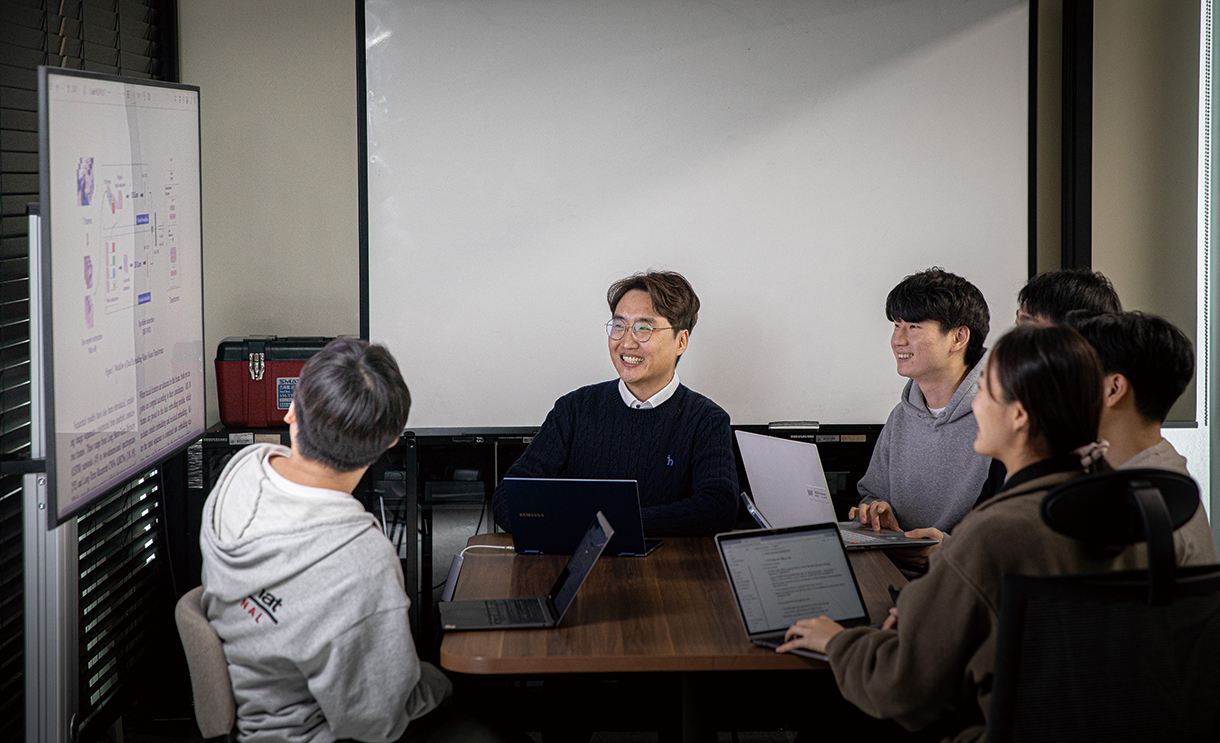
불편한 상호작용의 유용함
‘인간-인공지능 상호작용 연구실(Human-AI Interaction Lab)’을 이끄는 고민삼 교수도 인간과 인공지능 양쪽에 대한 이해를 바탕으로 더 이로운 인공지능 기술을 개발하기 위해 노력 중이다. ‘콜라보(Colorbo)’라는 이름의 프로젝트를 예로 들 수 있다. 예술 활동에 인공지능을 접목하는 프로젝트로, 인공지능 기술을 활용해 불교 미술의 일종인 만다라 문양을 채색하는 것이었다. 인공지능 기술 덕분에 복잡한 만다라 문양에 색을 채우며 완성된 모습을 미리 확인할 수 있고, 결과물이 마음에 들지 않으면 바로 수정할 수도 있어 더 나은 작품을 완성하게 했다.
“예술 활동은 인간의 독자적인 영역으로 여겨졌는데 이제 인공지능도 작품을 창작할 수 있게 됐습니다. 그렇다고 인공지능에 예술을 맡기면 인간은 창작의 즐거움을 향유할 수 없게 됩니다. 그래서 인공지능의 도움을 받으면서 초심자도 재미있게 창작의 주체가 될 수 있도록 예술 활동에 인공지능 기술을 적용했습니다.”
이외에도 고민삼 교수는 ERICA캠퍼스 인공지능융합센터의 지원을 받아 170개국에서 사용되는 알람 앱 ‘알라미’의 운영사인 ‘딜라이트룸’과 산학과제를 수행하고 있다. 알라미는 사진을 찍거나 스쿼트를 해야 알람이 해제되기 때문에 일명 미션 알람이라고 불리는데, 고민삼 교수는 사진 인증을 위한 모바일용 딥러닝 모델과 동작 인증을 위한 가속도계 등의 데이터 처리 모델을 개발했다. 이는 불편한 상호작용의 좋은 예라고 볼 수 있다. 이렇게 고민삼 교수는 인공지능으로 편리함뿐 아니라 불편함을 유발하는 기술까지 아우른다.
“사용자에게 불편함을 제공하지만, 궁극적으로는 이로운 가치를 지니기에 사용자가 잠시의 불편함을 감수하면서도 기꺼이 사용하는 것입니다. 인간-인공지능 상호작용의 기본 방향은 서비스 및 애플리케이션의 사용성을 높여 사람을 편하게 하는 것이에요. 하지만 우리 연구실은 당장은 불편하거나 힘들다 해도 사람이 해야만 하는 일에 인공지능을 활용해 더 높은 가치를 만들려 노력하고 있습니다.”
그러한 연구 중 하나가 2022년 12월 자연어 처리 분야의 우수 국제학술대회 EMNLP에서 발표한 ‘스튜봇(StuBot)’ 프로젝트다. 일반적으로 챗봇 서비스는 사용자가 요청하면 챗봇이 이에 반응해 사용자가 원하는 편의를 제공한다. 하지만 스튜봇은 이와 반대다. 챗봇이 요청하고 사람이 반응해야 한다. 학습이론 중에 ‘가르치며 공부하기(Learning by Teaching)’가 있는데, 이에 따라 설계된 스튜봇이 어리숙한 학생의 역할을 하며 사용자에게 학습 내용에 관해 설명해 달라고 요구한다. 그러면 학습자는 최선을 다해 설명해줘야 하는데, 이러한 과정을 통해 사용자는 학습 내용을 보다 잘 이해하게 된다.
The usefulness of inconvenient interaction
Professor Minsam Ko, the leader of the Human-AI Interaction Lab, is also working to develop more beneficial artificial intelligence technologies based on the understanding of both humans and AI. The project, called “Colorbo,” is one example. It is a project that applies artificial intelligence to art activity, using AI technology to color mandala patterns, a type of Buddhist art. Artificial intelligence enables users to fill the colors in complex mandala patterns, check the completed work in advance, and change it right away if you are not satisfied with the result, thus allowing users to get better results.
“Art activities were considered a domain exclusive to humans, but now artificial intelligence can also create artworks. However, if art is left to AI alone, humans will not be able to experience the joy of creation. We applied AI to art activities so that beginners can also be creators with the help of AI.”
In addition, Professor Ko is carrying out industry-academia research with DelightRoom, the operator of the alarm app, Alarmy, used in 170 countries, with support from the AI Convergence Research Center of ERICA Campus. Alarmy is also called a “mission alarm,” because the alarm stops only when the user takes a photo or does squats. Professor Ko developed a deep learning model for mobile devices for photo validation and a data processing model for an accelerometer for movement validation. This can be considered a good example of an inconvenient interaction. This is how Professor Ko uses artificial intelligence to embrace the technologies that provide not only convenience, but also inconvenience.
“It provides inconvenience to users, but it has beneficial values ultimately. That is why users are willing to use the technology despite the temporary inconvenience. The basic direction of human-AI interaction is to provide convenience to people by increasing usability of the services and applications. Our laboratory, however, is trying to create higher value by using artificial intelligence for tasks that must be done by humans, even if it is inconvenient or difficult at the moment.”
One such study is the StuBot project presented at EMNLP, a leading international academic conference in the area of natural language processing, in December 2022. In general chatbot services, when a user makes a request, a chatbot responds to provide the convenience requested by the user. However, StuBot is the opposite — the chatbot makes a request, and a person responds. There is a learning theory called “learning by teaching.” StuBot, designed according to this theory, plays the role of an inexperienced student, asking the user to explain the learning contents. The learner then needs to explain to the best of his/her knowledge. Through this process, the user can better understand the content.
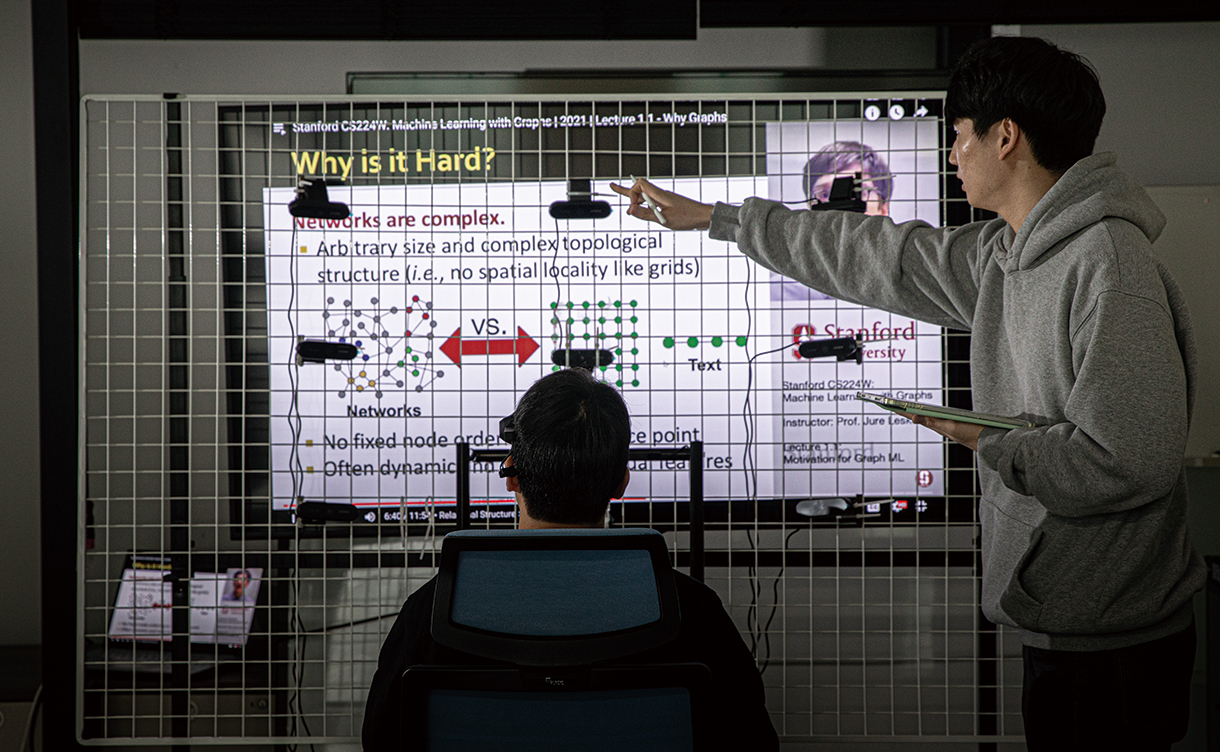
인간과 인공지능 양쪽에 대한 이해를 바탕으로, 인공지능 시대에서 사람이 여전히 주체적인 판단을 해나갈 수 있도록 인간-인공지능 상호작용이 설계돼야 한다
Human-AI interaction must be designed based on the understanding of both humans and AI, so that humans can continue to make independent judgments in the era of artificial intelligence.
AI 리터러시 역량이 요구되는 시대
인공지능이 보다 다양한 곳에서 더 높은 성능을 발휘하며 인간과 상호작용을 하게 되면 인공지능에 대한 의존도가 높아질 것이다. 그러한 상황에서 만약 정보가 통제되거나 편향된 정보가 확산한다면, 인공지능에 대한 신뢰도는 심각하게 훼손될 수밖에 없다.
“인공지능이 일상화되면 정보를 탐색하고 처리하는 방식에 큰 변화가 생길 것입니다. 미디어 리터러시, 디지털 리터러시처럼 AI 리터러시 즉, 인공지능이 내놓은 결과를 그대로 수용하는 것이 아니라 비판적으로 수용해 잘 활용할 수 있는 역량이 필요합니다. 인공지능 시대에서 사람이 여전히 주체적인 판단을 잘해갈 수 있도록 인간-인공지능 상호작용이 설계돼야 합니다.”
그래서 고민삼 교수는 인공지능을 통해 AI 리터러시를 돕는 방법을 연구하고자 한다. 예를 들면 인공지능 결과의 편향성을 분석해 제시하는 등 인공지능이 가진 위험성이나 한계를 극복하고 사용자에게 더 이롭게 쓰일 수 있는 서비스를 개발할 계획이다.
“우리는 이미 인공지능 시대에 살고 있습니다. 인공지능은 일반인에게도 이제 특별한 것이 아니라고 생각합니다. 자동차 내부를 잘 몰라도 운전을 잘할 수 있는 것처럼, 모두가 인공지능 내부를 자세히 공부할 필요는 없을 것입니다. 하지만 인공지능을 잘 활용할 수 있는 능력을 키우는 일은 점차 더 중요해질 것 같습니다. 분야에 상관없이 인공지능을 활용하는 AI 리터러시 역량을 쌓아야 합니다.”
인공지능을 잘 활용하기 위해서는 인공지능 결과를 비판적으로 수용할 수 있는 사고력을 길러야 한다는 게 고민삼 교수의 생각이다. 더불어 인공지능으로 무엇을 할 수 있을지 파악하고, 인공지능과 사람의 역할을 잘 구분해 이해하는 역량을 쌓아야 한다고 강조했다. 고민삼 교수는 이를 통해 한양인들이 인공지능이라는 날개를 달고 비상할 수 있기를 응원했다.
AI literacy capabilities are required in this era
As artificial intelligence demonstrates higher performance in more diverse areas while interacting with humans, dependence on AI will increase. If information is restricted or biased information spreads in such situations, reliability of AI will be severely undermined.
“When artificial intelligence becomes commonplace, there will be major changes in the way we search and process information. We will need AI literacy — in other words, the ability to critically accept and utilize the results that AI produces — instead of accepting them unconditionally, just like media literacy or digital literacy. For humans to continue to make independent judgments in the era of artificial intelligence, human-AI interaction must be designed properly.”
Therefore, Professor Minsam Ko seeks to study ways to help with AI literacy through artificial intelligence. He plans to develop services that will be more beneficial to users by overcoming the risks and limitations of AI — such as, for example, by analyzing and presenting the bias in AI results.
“We are already living in the era of artificial intelligence. Now, AI is not something special even for the general public. Just as you can drive without knowing the inside of a car, not everyone needs to study the inside of AI in detail. However, developing the ability to utilize AI will likely become increasingly important. Regardless of the field you're in, you need to build AI-literacy capabilities to utilize artificial intelligence.”
Professor Ko believes that one needs to develop the thinking ability to critically take AI results in order to utilize AI properly. In addition, he emphasized that we need to know what we can do with AI, and develop the ability to distinguish and understand the roles of AI and humans. Through this, Professor Ko hopes that members of Hanyang will soar higher with wings of artificial intelligence.
